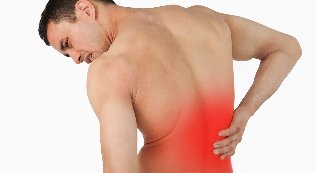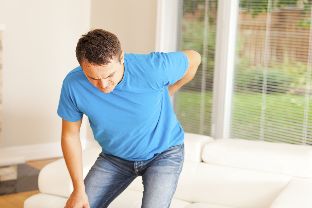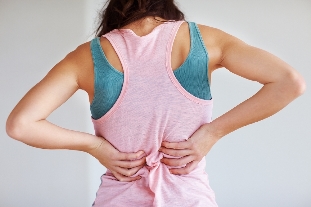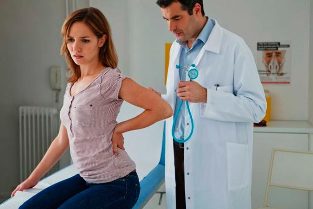Back pain - a common symptom. The majority of people at least once in their life, the meeting with him. This is one of the most common reasons for visits to the doctor and skip work.

Keywords: back pain, back pain, spine
Back pain can occur at any age, but is most common between 35 and 55 years. Pain in the spine connected with our bones, muscles, intervertebral discs, ligaments, tendons and nerves.
Back pain can be caused by problems with the vertebrae, discs, between them, the ligaments around the spine and discs, spinal cord and nerves, muscles, internal organs in the abdominal and pelvic areas. Also cause pain in the upper back can be diseases of the aorta, tumors in the chest and inflammation of the spine.
Risk Factors
The presence of risk factors increases the likelihood of development of a particular state. For example, obesity significantly increases the risk of diabetes type II.
The following factors are associated with an increased risk of back pain:
- work office;
- the work, along with the constant tension;
- pregnancy women who are pregnant often suffer from back pain;
- a sedentary lifestyle;
- the age;
- depression;
- obesity/overweight;
- Not;
- heavy physical exercise;
- heavy physical work.

Signs and symptoms back pain
A symptom is something the patient feels, while a sign can be noticed by the doctor. For example, pain is a symptom, while a rash is a symptom.
The main symptom of back pain is pain in any part of the back. Sometimes the pain extends to the buttocks and legs or the shoulder and the arm.
You should immediately contact a doctor if pain accompanies any of the following signs:
- the weight loss;
- at high temperature (fever);
- back pain ease after rest;
- the pain that radiates to the leg;
- the pain below the knee;
- the presence of new lesions of the spine;
- incontinence of urine (even small portions);
- difficulty urinating - urine passed with difficulty;
- fecal incontinence - loss of control over the process of bowel movement;
- numbness in the genital area;
- numbness of anus;
- sensation of numbness in the buttocks.
Seek the advice of experts if you belong to one of these groups:
- persons under the age of 22 or over the age of 55 years;
- patients who took steroids for a few months;
- patients with cancer;
- the patients who had cancer;
- patients with low immunity.
The causes of back pain
The human spine is a complex structure consisting of muscles, ligaments, tendons, disks and bones. Intervertebral discs are located between each pair of vertebrae and function as shock absorbers of the friction. Problems with any of these components can lead to pain in the spine. In some cases, the cause of the pain cannot be established.

Extends
The most common causes of back pain are:
- stretch the muscles;
- stretched ligaments;
- lift heavy objects in a wrong posture;
- lifting too heavy of a topic;
- the result of a sudden and awkward movement;
- spasm of the muscles.
Structural problems
The following structural problems, can cause back pain:
- output of the intervertebral disc. The rupture of the exterior of the housing of the disk leads to vbuhanie internal contents to the outside. This can lead to a pinched nerve and as a result, the pain;
- herniated disc - bulging of internal disk content of large dimensions;
- sciatica sharp and shooting pain that radiates to the buttock and back area of the feet, caused by the protrusion or herniation of intervertebral disc, compression of the nerve;
- arthritis - patients with osteoarthritis commonly experience problems with the joints of the hip, lumbar spine, knees and hands. In some cases there may be stenosis cord, as the space that surrounds the spinal cord is narrowed;
- abnormal curvature of the spine - if the spine curves in an unusual way the patient is more prone to suffer pain in the spine. An example of anomalous bending is scoliosis, in which curves of the spine to the side;
- osteoporosis - bones, including the vertebrae become fragile and porous, which leads to an increase of the breakdown.
Below are some other causes of back pain:
- cauda equina-horse tail is a bundle of nerve roots that branches off of the spinal cord. People with cauda equina syndrome feel a dull pain in the lumbar region of the spine and the buttocks. It can also be loss of sensation of the buttocks, genitals, thigh. Sometimes people with cauda equina syndrome suffer from incontinence of urine and/or feces;
- cancer of the spine - a tumor located in the spine, can compress the nerve, leading to pain;
- infection of the spine - if the patient has a high body temperature and painful hot area on the back, this may indicate infection of the spine;
- other infections - pelvic inflammatory disease in women, and infections of the bladder and the kidneys can also cause back pain;
- sleep disorders - people with sleep disorders are more likely to experience pain in the spine relative to the population in General;
- the herpes zoster infection, which can affect your nerves;
- bad mattress - if a mattress does not support specific parts of the body and ensures a flat back position, there is a risk of developing pain in the spine.
Also cause pain in the spine can be certain movements or body positions, such as prolonged driving, coughing, etc.

What to do when back pain
If you experience pain for several days, the following tips will help you reduce the pain and discomfort and speed of recovery:
- stay as active as possible;
- if necessary, use over-the-counter painkillers;
- use hot and cold compresses. Fits a bottle with hot water, and a bag of frozen vegetables.
Despite the fact that it is difficult to remain optimistic when you are in pain, try not to be discouraged. This will accelerate the healing process.
Prolonged pain that lasts for six weeks, you should consult a doctor. The doctor will take a history, conduct of the examination and, if necessary, sent for further study. Your doctor may order x-rays if you suspect a problem with the skeletal system or osteoarthrosis, CT (computed tomography) or MRI (magnetic resonance imaging) with suspected intervertebral hernia or any other problems associated with soft tissues or nerves. In this situation, the MRI is the best option. Also, the doctor may advise to do some lab tests or to measure the electrical activity of the nerves (EMG).
After diagnosis, the doctor prescribed a treatment. For the majority of cases, conservative treatment, which may include:
- special exercises;
- reflexology,
- traction of the spine;
- massage.
In severe cases, can be questioned about the operation. The surgeon will help you choose the appropriate method and advise on the possible complications. Some time after the operation, it is recommended step of treatment, prophylactic of the spine. Remember that the surgery is very dangerous, because the surgical area is located in the vicinity of nerves.





































